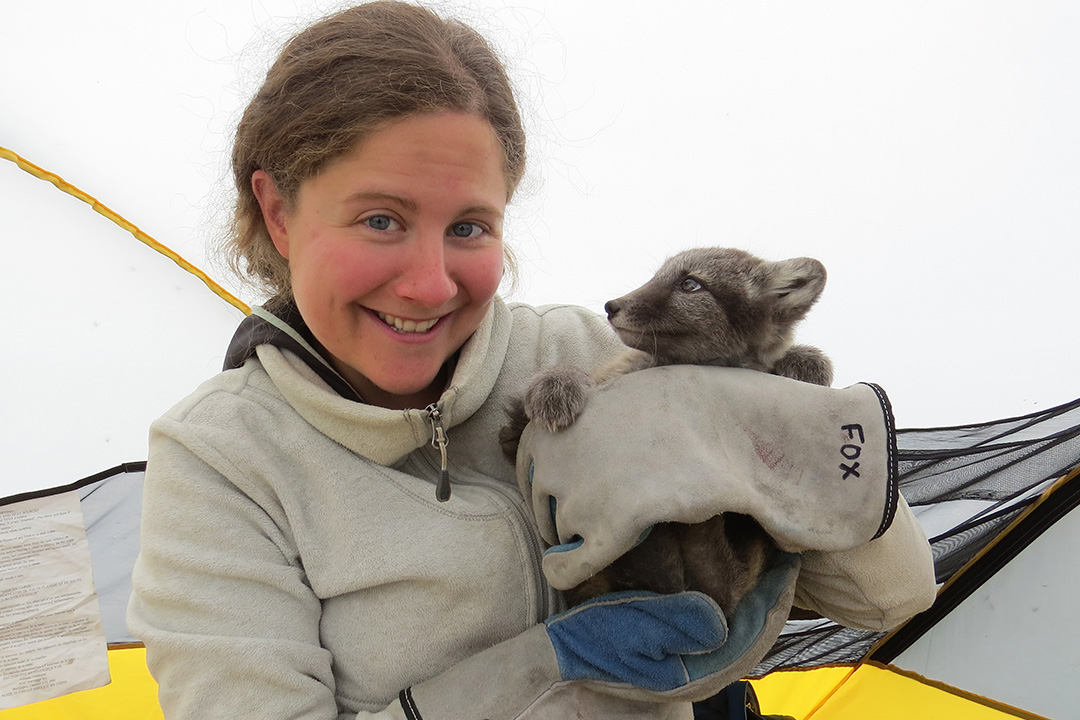
Student studies kitty-litter disease in Arctic foxes
A cat parasite is mysteriously proliferating in a fox population of the Canadian Arctic where there is hardly a cat to be found.
By Federica GiannelliUniversity of Saskatchewan researchers have found almost 60 per cent of foxes in Nunavut’s Queen Maud Gulf Bird Sanctuary show signs of disease exposure. The ‘kitty-litter-disease’ (toxoplasmosis) parasite, whose preferred host is cats, spreads through food, water and soil contaminated with cat feces.
“The parasite might be introduced by migratory geese infected during their travels,” said U of S veterinary microbiology professor Emily Jenkins. “Foxes likely get infected by eating the geese.”
Understanding how the parasite spreads in foxes could shed light on human exposure in the Arctic and, possibly, reduce it. Some Inuit communities have two to five times the exposure rate of other North Americans, possibly linked to harvesting and consuming local wildlife.
Often displaying no symptoms, toxoplasmosis is dangerous only for people with decreased immunity and for pregnant women infected for the first time, resulting in higher miscarriage rates and health problems in newborns.
“The disease may cause fox deaths and hinder reproduction of Arctic wildlife,” said U of S PhD student Émilie Bouchard.
Bouchard and her supervisor Jenkins are the first to have found evidence that pregnant fox mothers may transmit the parasite to their pups through the placenta during pregnancy. This could shed light on why this parasite is so successful in this Arctic fox population.
Bouchard spent the last two summers live-trapping foxes and taking blood samples at a field camp at Karrak Lake, near the Arctic Circle.
She is the first to show that a special blood test, usually performed only in the lab, can be used successfully in the field.
If community members were trained as monitors in using the field blood test on freshly hunted wildlife, they would save time and money on shipping samples south to a lab, she said. This could help prevent Arctic people from consuming meat possibly contaminated with the parasite.
“It’s like playing detective,” said Bouchard. “The blood test tells you whether the animals are exposed to toxoplasmosis but it doesn’t tell you how. You have to put the pieces together.”
As in humans, the blood test results indicate that fox mothers who get the disease earlier in life seem to develop immunity, thus reducing the chance to transmit it to their pups.
But Bouchard also found a litter that was infected even though the mother had immunity. This suggest that infection in foxes may also happen in more than one litter from the same mother.
“They were all still drinking mother’s milk so infection through contaminated meat seems unlikely,” Bouchard said.
Jenkins said pregnant foxes who test negative for the disease lack immunity from previous exposure, so they and their unborn pups are considered vulnerable to infection.
Bouchard’s research will help develop better practices for human and wildlife health protection. Federal agencies NSERC, Canada Foundation for Innovation, Canadian Polar Commission, ArcticNet Network for Centres of Excellence, and Natural Resources Canada are funding the project.
Federica Giannelli is a graduate student intern in the U of S research profile and impact unit.
This article first ran as part of the 2016 Young Innovators series, an initiative of the U of S Research Profile and Impact office in partnership with the Saskatoon StarPhoenix.

